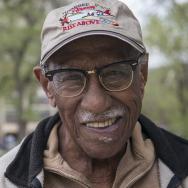In February 1926, historian Carter G. Woodson came to the Wabash YMCA in Bronzeville to announce the creation of Negro History Week—the forerunner of what would become the nation’s annual commemoration of Black History Month each February.
Woodson, who had graduated from the University of Chicago in 1908 with bachelor’s and master’s degrees in history, was determined to transform how people thought about black history. He succeeded on a grand scale, though it took more than 50 years for the effort to gain widespread acceptance. For one of Woodson’s audience members, a seven-year-old boy named Timuel Black, the effect would be intensely personal.
Black, AM’54, remembers his father bringing him to the Wabash Y that day to hear Woodson’s announcement. He recalls Woodson explaining how life in the United States could not be fully and correctly understood without studying the contributions of African Americans, whose role in history texts of that era was often invisible, or limited to accounts of slavery.
Black, now 96, said hearing Woodson and later reading his works such as The Mis-Education of the Negro served as an inspiration as he pursued his own path as a trailblazing South Side historian, activist and teacher. Without a sense of having contributed anything, Woodson argued, African American students are directly and indirectly taught to feel and act inferior.
“The experience became a powerful part of my education, which I tried to share later as I taught black history,” Black said, “or, ‘corrected American history,’ as I called it.”
Woodson’s impact on the South Side of Chicago has only grown in recent years. In 2008, 100 years after Woodson received his degree from UChicago, the University opened the Carter G. Woodson middle school campus of the UChicago Charter School. Woodson’s legacy can be felt among many of those who carry on his life’s work of education.
Education shaped by Woodson’s work
Carol Adams, former CEO of Chicago’s DuSable Museum of African American History near the UChicago campus, said Woodson’s work was a major inspiration to her as a scholar-activist.
“He didn’t just see a need, he moved to fill the need,” Adams said. “It wasn’t easy to get your work published if you were an African American scholar, for example, so he started a journal and then a press,” Adams said, referring to Woodson’s creation of the peer-reviewed Journal of Negro History and the ASALH Press.
Adams sees a direct connection between Woodson’s work and the Illinois General Assembly’s 2005 enactment of the Amistad Commission, on which both she and Black serve. The commission was charged with addressing the state’s need for a public school curriculum “rooted in the teachings about the legacy of slavery in America, African American contributions to the U.S. and the hardships that African Americans have endured in the past 409 years” and recommending changes to curriculum and textbook content.
Adams said she is happy to have played a role in helpful to fulfill the broader potential of Negro History Week. She was present for one of the first steps toward this goal, when black history week became black history month. Although the change didn’t take place on a national level until 1976, its seeds took root where the annual celebration was first announced—in Chicago.
“I was sitting in the room when it happened,” said Adams, who did doctoral work at the University of Chicago while working as a research assistant for prominent sociologist Horace Cayton. She later served as research director for the Center for Inner City Studies at Northeastern Illinois University, director for Loyola University’s African American studies program, and secretary of the Illinois Department of Human Services before taking the helm at DuSable.
Negro History Week originally had been chosen to coincide with the February birthdays of Abraham Lincoln and Frederick Douglass. But by the early 1970s the activities being squeezed into that week had grown too numerous to manage. So a meeting was held at the Black People’s Topographical Research Center on the South Side for everyone involved in an organization that was planning an event.
“We got together to do a common calendar, and there were simply too many things to do in one week,” Adams said. “So we decided, let’s do a month! We called it Black Liberation Month, but it eventually became formalized as Black History Month in Chicago.”
Woodson’s work guided Adams’ efforts as she developed the Amistad-mandated Chicago Public Schools Teacher Training Programs at DuSable. “We fought to be the ones to develop that curriculum at the DuSable museum, and we’ve been doing it across the curriculum in all subject matters and all grade levels,” she said.
If anything, the mission that Woodson began is more vital than ever, Adams said.
“We need to talk about black history not just in the month of February, but we need to talk about it in World History and U.S. History, Adams said. “Because if we’re left out, nobody’s getting it right.”
